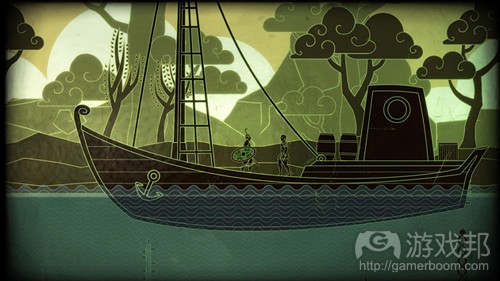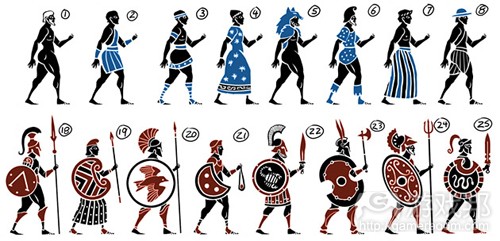Alientrap谈古代艺术题材的《Apotheon》创作过程
作者:Eric Caoili
《Apotheon》看起来与独立开发商Alientrap前作《陨落异星》并不相同,它以葱绿的外来世界作为故事背景,而游戏画面则由手工绘制的精致外来植物插图组成。
其实,这款最新作品更像最近几年兴起的以斑点构图的横版游戏(游戏邦注:例如《Limbo》、《Insanely Twisted Shadow Planet》及《Outland》)。然而,《Apotheon》采用的是不同以往的美学风格,以点缀古希腊陶器的“黑人”形象作为游戏图画。
如果Alientrap团队仍停留在该项目的最初理念:即以网络朋克为背景,以科幻为主题,并融合一些神话元素的开放式场景游戏。那么这家位于加拿大的游戏工作室可能不会采用这个不同寻常的美术设计。
一开始,《Apotheon》设定的是“希腊神话空间”,后来该工作室删掉了“空间”一词,他们认为经典神话便是创作电子游戏故事的最佳选择,《战神》便是一个成功案例。
Alientrap美工及联合设计师Jesse McGibney表示:“黑人陶的艺术类型似乎十分简单。其人物形象简单、大胆且显而易见,十分适合2D平台,而且其形象也完美地吻合了游戏的故事与主题。坦白讲,我们十分惊讶之前从未有一款游戏采用这种风格。”
当你着眼于此时,你会发现,许多电子游戏还未挖掘古代艺术题材。McGibney指出:“只要任意翻开艺术史书的任何一页,你定能从中吸取大量创作灵感——比如埃及的象形文字、中世纪的挂毯、史前的洞穴壁画、印第安人的洞穴等。我希望3D游戏也可以以立体派画家毕加索的作品为题材。”
古代艺术题材的局限性
McGibney承认:“在形成这个创作理念之初,我们已经认识到完全照搬黑人图画并无多大效果。”大部分黑人图画均以人物为中心,着重塑造有关人物与上帝的故事,除了一些摆设或植物,鲜少涉及环境描写。
McGibney解释道:“显然,开放式场景游戏中一大部分均与环境有关,因此,我们必须扩展这类题材,添加建筑物、洞穴、树林以及源材料所缺失的其它场景。我们应利用图案与几何图形创造出一种统一语言,我们应保证所有元素为统一模式。”
该团队还需解决古希腊陶器上无任何背景或重复元素的扁平美术图像的问题,因为这种画面并不会在电子游戏中给玩家带来视觉冲击或产生可视环境。
McGibney解释道:“为了在游戏世界中解决这些问题,游戏背景与事物应存在视差,从而突出事物特征。如果我们无法做到,那么整个游戏世界将给人一种稀疏与单调的感觉。而黑人陶的背景也只有红色一种。”
色彩的局限性
游戏在美术风格方面存在的另一个问题为黑人图画只包含两种颜色,黑色与红色(游戏邦注:虽然有时会点缀白色或暗红色)——而美工无法利用这些单调的色彩种类来设计游戏。
为了更能够区分环境与相关色彩,Alientrap在游戏中引入大量色彩,以此打破原本的单调画面。比如,他们选用默认颜色红、黄、橙描绘户外与城市,营造明亮温暖的环境。《Apotheon》中的树林或野外地区则采用绿色,而其它较冷清部分(比如,地下区域)则采用蓝色。
McGibney补充道:“玩家角色的色彩也十分重要,但仅用一种颜色却难以突显其特征。如果所有角色、道具、环境元素均为黑色,那么玩家就难以辨认出哪些属于重要部分,哪些不是。”
“我们在描绘玩家角色的眼睛时一般选用亮色,以便玩家一眼识别自己看到的事物。比如,敌人的眼睛是红色的,而玩家角色是绿色的,安全的道具为鲜红色,金币为黄色等。黑人陶题材确实是个不错的出发点,但为了兼顾玩家的游戏体验,我们应灵活设计整款游戏画面。”
服饰与动画
鉴于这些美术题材拥有上千年历史且从未呈现任何运动形式,对Alientrap而言,为它们添加动画效果实则非常简单。McGibney利用某个社区开发出的骨骼动画,编辑并创立出类似纸片人的由一个个关节连接而成的角色与动物。
他指出:“陶器上的大部分人物均为侧面形象,且摆出向前进的动作,这些动作能够直观地解释源材料。陶器上的许多人物均向侧面奔跑。”
但美工还需面临一些挑战,其中最大的挑战当数描绘角色的服饰——McGibney解释道,许多古希腊的人们都喜欢穿宽外袍与长斗篷,而在某个动画角色身上却难以同时体现这两个元素。
他表示:“我们为一些瘦骨如柴的角色罩上了又大又宽松的‘裙子’,以便说服人们这是裙子或者长袍,然而,当我制作出全新的角色时,我仍得在服装设计上做出一些让步。幸好,就像喜欢他们的宽外袍一样,希腊人似乎更喜爱暴露身体的某些部位。”(本文为游戏邦/gamerboom.com编译,拒绝任何不保留版权的转载,如需转载请联系:游戏邦)
Apotheon makes ancient art work in a modern game
by Eric Caoili
Apotheon looks nothing like the last game independent developer Alientrap put out, Capsized — that title inhabited a verdant alien world, lush with detailed hand-drawn illustrations of the planet’s exotic flora.
This newest project more resembles the rash of silhouetted sidescrollers that have popped up in recent years, like Limbo, Insanely Twisted Shadow Planet, and Outland. But Apotheon stands out from that style by adopting an aesthetic that’s hardly been explored in games, the “Black Figure” paintings that adorn ancient Greek pottery.
It’s a striking look the Canadian studio might have never settled on if the team stayed with the project’s initial concept: a cyberpunk, sci-fi-themed open-world game with some mythological trappings.
Apotheon started as “space Greek mythology” before the studio dropped the “space” part and realized classical mythology alone is a great source for stories that translates well to video games, which the God of War series can attest to.
“The Black Figure pottery art style seemed like a no-brainer after that,” Alientrap artist and co-designer Jesse McGibney tells Gamasutra. “It’s simple to animate, bold and easy to read, transitions great into a 2D platformer perspective, and perfectly meshes with the narrative and theme. We were honestly surprised that hardly any games have used this style before.”
When you think about it, there are plenty of ancient art styles that have yet to be explored in video games. “You could flip to a random page in any art history book and find a goldmine of inspiration to draw on — Egyptian hieroglyphics, Medieval tapestry, prehistoric cave paintings, Native American carvings,” says the artist. “Heck, I would love to see a 3D game using crazy multi-perspective cubist Picasso paintings.”
The limitations of an ancient art style
“Pretty early on in concepting we realized that a totally literal adaptation of Black Figure art wouldn’t work very well,” McGibney admits. Most of the art in Black Figure paintings are character-centric, focusing heavily on the people and gods in the stories they’re portraying, with little environmental representation beyond furniture or plants.
“Obviously, a big part of an open world game is the environments, so we had to expand the style to show buildings, caves, forests, and many other locations that are totally absent in the source material. We’re trying to create a unified language through the use of patterns and geometric shapes that are common throughout all the elements,” he explains.
Something else the team had to contend with is that the art on ancient Greek pottery tended to be very flat, with no backgrounds or overlapping elements, which doesn’t make for visually exciting or readable environments in a video game.
The artist explains, “In order to make it work in the game world, things in the background are faded out and there are parallax layers further back. If we didn’t do these things, the game world would be extremely sparse and boring. The background of Black Figure pottery is just… red.”
Beyond black and red
Another problem with the art style is that Black Figure paintings typically have just two colors, black and red (though sometimes accompanied by white and darker red embellishments) — a limited color palette that doesn’t give video game artists much to work with.
To create more distinction between environments and their tone, Alientrap ended up introducing alternative palettes and lots of colored lighting to break up the monochrome. The default palette — red, orange, and yellow — for example, is used for outdoors and cities, communicating bright and warm environments. Apotheon’s forested or wild areas use green, while cooler sections (e.g. underground areas) are presented in blue.
“Player communication is also very important, and it’s really hard to do that with only one color,” McGibney adds. “If all the characters were black, all the items were black, all the environmental elements were black, it would be very difficult to tell what was important and what wasn’t.
“We added splashes of color to draw the player’s eye and let them know what they’re seeing at a glance. Enemies all have red in them, the player is green, health items are bright red, money is yellow, etc. The Black Figure style is a great starting point, but we’re trying to be flexible with it where the gameplay experience is concerned.”
Togas and animation
Animating an art style that’s a couple of millenia old and was never intended for movement was actually pretty straightforward for Alientrap, considering. McGibney used a community-developed skeletal animation editor, and set up the game’s characters and animals like paper puppets, with parts hinging on their joints.
He points out, “Most of the characters in the pottery are from a profile view, and occasionally straight on (no one had really figured out that whole perspective thing yet), so the movements are a pretty literal interpretation of the source material. Lots of guys running sideways on those pots.”
But there were some challenges, the biggest of which was animating characters’ clothing — McGibney notes that many ancient Greeks loved wearing togas and long flowy capes, both potentially difficult to translate convincingly on an animated character.
“Some characters have big baggy ‘skirts’ built into their animation skeleton that can make convincing dresses or robes, but I still have to make a few design concessions when making new characters,” he says. “Luckily, as much as they liked their togas, the Greeks seemed to like being butt-naked even more.” (source:gamasutra)










































 闽公网安备35020302001549号
闽公网安备35020302001549号